SMARTSCORE EXAMS
Hello, every!
There are many writers you come across but I consider myself the one you will not have to move on from. Having 7 years of experience as an academic writer, I’m well-versed in:
-Writing dissertations/thesis (qualitative and quantitative)
-Assignments
-Weekly discussions of courses
-Quizzes
-Research Proposal
I have command over all referencing styles including APA, Harvard, Chicago, etc. And can work on all subjects including Business Administration, Nursing, Psychology, Biology, Law, HR, etc.
Hoping to get in touch with you!
- 2977
- 0
- 229
Community
- Followers
- Following
65 Reviews received
3211 items
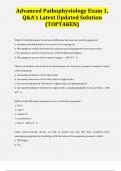
Advanced Pathophysiology Exam 1, Q&A’s Latest Updated Solution (TOPTAKEN)
Examples of edema caused by decreased capillary oncotic pressure - ANS - -cirrhosis, malnutrition (decreased synthesis of plasma proteins) -nephrotic syndrome (increased loss of plasma proteins) -Increased plasma Na and H2O retention (dilution of plasma proteins) Examples of edema caused by increased capillary permeability - ANS - -burns -inflammation -neoplastic disease -allergic reactions -infection Loss of plasma proteins to interstitial space leading to increased tissue oncotic p...
- Package deal
- Exam (elaborations)
- • 49 pages •
Examples of edema caused by decreased capillary oncotic pressure - ANS - -cirrhosis, malnutrition (decreased synthesis of plasma proteins) -nephrotic syndrome (increased loss of plasma proteins) -Increased plasma Na and H2O retention (dilution of plasma proteins) Examples of edema caused by increased capillary permeability - ANS - -burns -inflammation -neoplastic disease -allergic reactions -infection Loss of plasma proteins to interstitial space leading to increased tissue oncotic p...
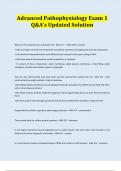
Advanced Pathophysiology Exam 1 Q&A’s Updated Solution
What are the signs and symptoms associated with hypernatremia - ANS - thirst, fever, dry mucous membrane, hypotension, tachycardia, restlessness, low jugular venous pressure. Why does giving insulin reduce potassium? - ANS - Insulin carries potassium back into the cell What are the signs and symptoms of hyponatremia - ANS - Seizure, headache, neurological changes, confusion. Nausea, muscle cramps What factors influence calcium and phosphate balance? - ANS - Calcium and phosphate bal...
- Package deal
- Exam (elaborations)
- • 17 pages •
What are the signs and symptoms associated with hypernatremia - ANS - thirst, fever, dry mucous membrane, hypotension, tachycardia, restlessness, low jugular venous pressure. Why does giving insulin reduce potassium? - ANS - Insulin carries potassium back into the cell What are the signs and symptoms of hyponatremia - ANS - Seizure, headache, neurological changes, confusion. Nausea, muscle cramps What factors influence calcium and phosphate balance? - ANS - Calcium and phosphate bal...
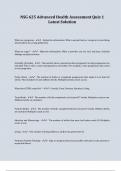
Bundled NSG 625 Advanced Health Assessment Exams With Latest Updated Solutions
Bundled NSG 625 Advanced Health Assessment Exams With Latest Updated Solutions
- Package deal
- • 4 items •
- NSG 625 Advanced Health Assessment Quiz 1 Latest Solution • Exam (elaborations)
- NSG 625 Advanced Health Assessment Quiz 2 Latest Top Solution • Exam (elaborations)
- Advanced Health Assessment NSG 625 Quiz 3 Updated Solution • Exam (elaborations)
- Advanced Health Assessment NSG 625 Quiz 4 Updated Top Solution • Exam (elaborations)
Bundled NSG 625 Advanced Health Assessment Exams With Latest Updated Solutions
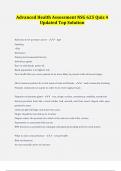
Advanced Health Assessment NSG 625 Quiz 4 Updated Top Solution
What does it mean if moro reflex is present past 6 months of age - - suspect presence of neurological disease What does an asymmetrical moro reflex indicate - - brachial plexus palsy or unilateral fracture of the humerus or clavicle Rooting reflex - - examiner strokes the corner of the infants mouth or cheek while the infant is lying quietly with hands held against the chest infant will turn head to the same side stroked by the examiner and open his/her mouth to grasp the examin...
- Package deal
- Exam (elaborations)
- • 39 pages •
What does it mean if moro reflex is present past 6 months of age - - suspect presence of neurological disease What does an asymmetrical moro reflex indicate - - brachial plexus palsy or unilateral fracture of the humerus or clavicle Rooting reflex - - examiner strokes the corner of the infants mouth or cheek while the infant is lying quietly with hands held against the chest infant will turn head to the same side stroked by the examiner and open his/her mouth to grasp the examin...
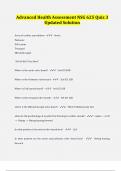
Advanced Health Assessment NSG 625 Quiz 3 Updated Solution
How to apply diaphragm of stethoscope - - firmly When to use diaphragm of stethoscope - - with high pitched sounds i.e. valve closure, systolic events, and regurgitate murmurs When to use bell of stethoscope - - with low pitched sounds i.e. gallops, murmur, AV stenosis what happens to PMI in COPD - - shifts down and to the right What happens to the PMI during pregnancy? - - shifted upward 1-1.5 cm (about 1 space) heaves/lifts - - sustained forceful thrusting of ventricle d...
- Package deal
- Exam (elaborations)
- • 30 pages •
How to apply diaphragm of stethoscope - - firmly When to use diaphragm of stethoscope - - with high pitched sounds i.e. valve closure, systolic events, and regurgitate murmurs When to use bell of stethoscope - - with low pitched sounds i.e. gallops, murmur, AV stenosis what happens to PMI in COPD - - shifts down and to the right What happens to the PMI during pregnancy? - - shifted upward 1-1.5 cm (about 1 space) heaves/lifts - - sustained forceful thrusting of ventricle d...
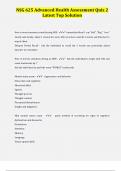
NSG 625 Advanced Health Assessment Quiz 2 Latest Top Solution
Secondary headaches - - occur due to an underlying cause and can be benign or serious. Common causes of secondary headaches include Viral syndrome Medication-induced headache (eg, caffeine, alcohol, analgesics, monosodium glutamate, oral contraceptive pills) Temporomandibular joint (TMJ) dysfunction Sinusitis Cervicogenic headache Serious causes of secondary headaches - - Giant cell arteritis Brain tumors Metastatic cancer Stroke Subarachnoid hemorrhage Arteriovenous malformation ...
- Package deal
- Exam (elaborations)
- • 44 pages •
Secondary headaches - - occur due to an underlying cause and can be benign or serious. Common causes of secondary headaches include Viral syndrome Medication-induced headache (eg, caffeine, alcohol, analgesics, monosodium glutamate, oral contraceptive pills) Temporomandibular joint (TMJ) dysfunction Sinusitis Cervicogenic headache Serious causes of secondary headaches - - Giant cell arteritis Brain tumors Metastatic cancer Stroke Subarachnoid hemorrhage Arteriovenous malformation ...

NSG 625 Advanced Health Assessment Quiz 1 Latest Solution
What can hypoactive or absent abdominal sounds indicate? - - Postoperative paralytic ileus or peritonitis related paralytic ileus. Paralytic ileus - - Also known as functional ileus, this is a condition that occurs when the muscles of the intestines are temporarily paralyzed, preventing food from passing through Peritonitis - - Inflammation of the peritoneum (membrane lining the abdominal cavity and surrounding the organs within it) What can hyperactive bowel sounds indicate? - - ea...
- Package deal
- Exam (elaborations)
- • 7 pages •
What can hypoactive or absent abdominal sounds indicate? - - Postoperative paralytic ileus or peritonitis related paralytic ileus. Paralytic ileus - - Also known as functional ileus, this is a condition that occurs when the muscles of the intestines are temporarily paralyzed, preventing food from passing through Peritonitis - - Inflammation of the peritoneum (membrane lining the abdominal cavity and surrounding the organs within it) What can hyperactive bowel sounds indicate? - - ea...
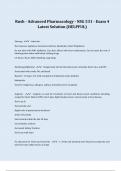
Rush - Advanced Pharmacology - NSG 531 - Exam 4 Latest Solution (HELPFUL)
When PDL1 binds to PD1 inhibits the cytotoxic activity of the T cell - cancer cells have evolved to be able to turn off the body's defense pembrolizumab is going to bin to PD1 so that PDL1 cannot and the T cell is not inhibited nitrosoureA - - alkylating agent very lipid soluble - can cross BBB effective for brain tumors Microtubule DE polymerization inhibitor - - once the microtubules are constructed they also have to be torn down. if they remain intact then the cells get stuck to...
- Package deal
- Exam (elaborations)
- • 10 pages •
When PDL1 binds to PD1 inhibits the cytotoxic activity of the T cell - cancer cells have evolved to be able to turn off the body's defense pembrolizumab is going to bin to PD1 so that PDL1 cannot and the T cell is not inhibited nitrosoureA - - alkylating agent very lipid soluble - can cross BBB effective for brain tumors Microtubule DE polymerization inhibitor - - once the microtubules are constructed they also have to be torn down. if they remain intact then the cells get stuck to...

Rush - Advanced Pharmacology - NSG 531 - Exam 1 Questions & Answers
What do excitatory NT bind to? - - ligand gated sodium channels and open them up If it reaches -55 then it will fire What do inhibitory NT bind to? - - potassium gated ion channel Potassium then leaves the cell taking its positive current with it and takes the voltage inside the cell further from threshold so that it will need a larger than normal stimulus because it is further away from threshold could also bind to chloride channels - chloride will move in which is negative Glutamate ...
- Package deal
- Exam (elaborations)
- • 7 pages •
What do excitatory NT bind to? - - ligand gated sodium channels and open them up If it reaches -55 then it will fire What do inhibitory NT bind to? - - potassium gated ion channel Potassium then leaves the cell taking its positive current with it and takes the voltage inside the cell further from threshold so that it will need a larger than normal stimulus because it is further away from threshold could also bind to chloride channels - chloride will move in which is negative Glutamate ...
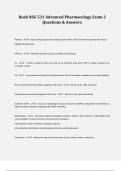
Rush NSG 531 Advanced Pharmacology Exam 2 Questions & Answers
Beta 1 receptors - - Heart: increase cardiac rate (chronotropic) and increase force of contraction (inotropic) Juxtaglomerular cells: increase renin release Isoproterenol - - Beta 1 prototypic agonist; nonselective, used for bronchodilation (beta 2) and cardiac stimulant (beta 1) Metoprolol - - Beta 1 prototypic antagonist Heart: reduces rate and force of contraction, inhibits impulse conduction Kidney: suppresses renin secretion
- Exam (elaborations)
- • 5 pages •
Beta 1 receptors - - Heart: increase cardiac rate (chronotropic) and increase force of contraction (inotropic) Juxtaglomerular cells: increase renin release Isoproterenol - - Beta 1 prototypic agonist; nonselective, used for bronchodilation (beta 2) and cardiac stimulant (beta 1) Metoprolol - - Beta 1 prototypic antagonist Heart: reduces rate and force of contraction, inhibits impulse conduction Kidney: suppresses renin secretion

NRNP 6675 Week 11 Final Exam 2022-2023 100% GUARANTEED TO PASS (A+ GRADED)
NRNP 6675 REVIEW TEST SUBMISSION MIDTERM EXAM WEEK 6 LATEST SOLUTION UPDATE 100% CORRECT.
NRNP 6675 WEEK 6 MIDTERM EXAM 2022 LATEST UPDATE 100% GUARANTEED SATISFACTION.
NRNP 6675 MIDTERM STUDY GUIDE 2022-2023 LATEST UPDATE (100% GUARANTEED HELPFUL).
GA MLS Real Estate Practical Final Exam Questions With Answers 2023 Solution